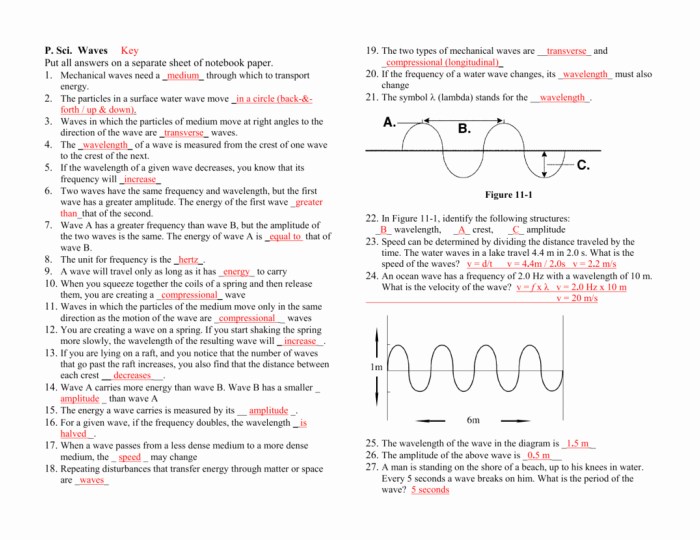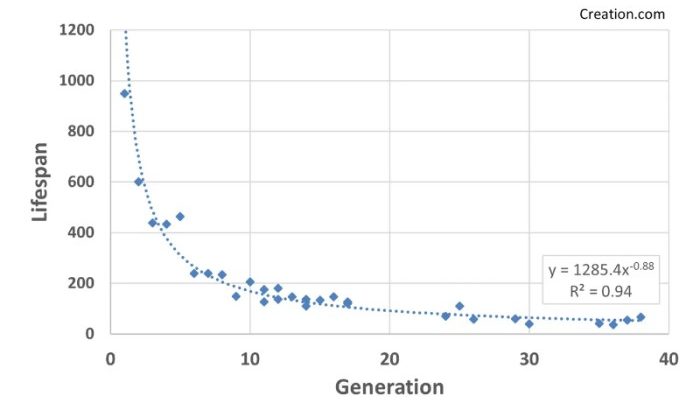Embark on a captivating journey into the realm of waves with our anatomy of a wave worksheet. This comprehensive guide unravels the intricacies of waves, their properties, types, behaviors, and practical applications, leaving you with an in-depth understanding of these fascinating phenomena.
Prepare to immerse yourself in the world of waves, where every crest and trough holds a story waiting to be discovered.
Basic Wave Structure
Waves are characterized by a unique structure that includes specific components. Understanding these components is crucial for comprehending wave behavior.
A wave consists of several key parts: the crest, trough, wavelength, and amplitude. Each part plays a distinct role in defining the wave’s properties.
Crest
The crest of a wave represents the highest point of the wave, where the wave’s displacement is at its maximum. It is the point at which the wave has the greatest elevation.
Trough
The trough of a wave, in contrast to the crest, represents the lowest point of the wave, where the wave’s displacement is at its minimum. It is the point at which the wave has the greatest depression.
Wavelength
The wavelength of a wave is the horizontal distance between two consecutive crests or troughs. It is a measure of the wave’s spatial extent.
Amplitude
The amplitude of a wave is the vertical distance between the crest and the trough. It is a measure of the wave’s height or strength.
These components are interconnected and define the overall shape and characteristics of a wave. The wavelength and amplitude together determine the wave’s energy and propagation speed.
Wave Properties

Wave properties describe the characteristics of a wave that define its behavior and propagation. Two key wave properties are wave velocity and wave frequency.
Wave Velocity
Wave velocity, often denoted as ‘v,’ measures the speed at which a wave travels through a medium. It is calculated as the distance traveled by the wave crest or trough over a given time interval.
For example, if a wave travels 10 meters in 2 seconds, its velocity is 5 meters per second.
Wave Frequency
Wave frequency, denoted as ‘f,’ measures the number of wave cycles that pass a fixed point in a given time interval. It is measured in Hertz (Hz), which represents one cycle per second.
For example, if 10 wave cycles pass a point in 1 second, the wave frequency is 10 Hz.
Wave Types
Waves can be classified based on their medium of propagation, which determines their characteristics and behavior. There are three main types of waves: transverse, longitudinal, and surface waves.
Transverse Waves
Transverse waves are characterized by the perpendicular oscillation of particles relative to the direction of wave propagation. In other words, the particles move up and down or side to side as the wave passes through.
Examples of transverse waves include:
- Electromagnetic waves (e.g., light, radio waves)
- Mechanical waves in a rope or string
- Seismic waves (S-waves)
Longitudinal Waves, Anatomy of a wave worksheet
Longitudinal waves, in contrast to transverse waves, involve the parallel oscillation of particles relative to the direction of wave propagation. In this case, the particles move back and forth along the same axis as the wave.
Examples of longitudinal waves include:
- Sound waves in a medium
- Seismic waves (P-waves)
- Pressure waves in a fluid
Surface Waves
Surface waves are a special type of wave that propagates along the boundary or interface between two media with different densities. These waves are typically found on the surface of water or at the interface between two different materials.
Examples of surface waves include:
- Water waves (e.g., ripples, tsunamis)
- Love waves (seismic waves)
- Surface plasmon waves
Wave Behavior
Waves exhibit a range of behaviors when interacting with obstacles or boundaries. These behaviors include reflection, refraction, and diffraction.
Wave Reflection
Wave reflection occurs when a wave encounters a solid surface and bounces back. The angle of reflection is equal to the angle of incidence, creating a mirror-like effect. For example, sound waves reflect off walls, causing echoes in enclosed spaces.
Wave Refraction
Wave refraction occurs when a wave passes from one medium to another with a different speed. The wave bends as it crosses the boundary, changing its direction of travel. For example, ocean waves refract when they enter shallow water, causing them to slow down and change direction.
Wave Diffraction
Wave diffraction occurs when a wave encounters an obstacle or narrow opening. The wave spreads out and bends around the obstacle, creating a new wave pattern. For example, water waves diffract around rocks or piers, creating ripples and distortions in the water.
Wave Applications
Waves find extensive applications in various scientific and technological fields. They play a crucial role in communication, medicine, and technology, enabling us to harness their properties for practical purposes.
The anatomy of a wave worksheet provides a detailed overview of the different parts of a wave, including the crest, trough, wavelength, and amplitude. If you’re looking for additional resources on language arts, I recommend checking out abeka spelling and poetry 2 . This comprehensive curriculum covers a wide range of topics, including spelling, grammar, and poetry.
Returning to the anatomy of a wave worksheet, it’s an excellent resource for students who want to learn more about this fundamental concept in physics.
In technology, waves are utilized in numerous applications, including:
Electromagnetic Waves
- Communication:Radio waves, microwaves, and infrared waves are used for wireless communication, allowing for the transmission of data, voice, and video over long distances.
- Navigation:Radar systems employ radio waves to detect and locate objects, aiding in navigation and collision avoidance.
- Imaging:X-rays and ultrasound waves are used in medical imaging techniques, providing valuable insights into the human body.
- Power transmission:Microwaves are employed in wireless power transmission systems, enabling the transfer of energy over short distances without the need for physical wires.
Mechanical Waves
- Sound waves:Used in communication (e.g., speech, music), medical diagnostics (e.g., ultrasound), and underwater exploration (e.g., sonar).
- Seismic waves:Utilized in seismology to study the Earth’s interior and detect earthquakes.
- Water waves:Harnessing the energy of waves for electricity generation (e.g., wave power plants) and recreational activities (e.g., surfing, sailing).
In medicine, waves play a vital role in diagnostic and therapeutic applications:
Medical Imaging
- X-rays:Generate images of bones and dense tissues, aiding in the diagnosis of fractures and other abnormalities.
- Ultrasound:Provides real-time images of soft tissues and organs, enabling the visualization of blood flow and organ function.
- Magnetic resonance imaging (MRI):Uses magnetic fields and radio waves to create detailed images of the body, helping diagnose a wide range of medical conditions.
Therapeutic Applications
- Ultrasound therapy:Utilizes sound waves to promote tissue healing and reduce pain.
- Shock wave therapy:Employs high-energy sound waves to treat chronic pain and musculoskeletal disorders.
- Laser therapy:Uses concentrated light waves to stimulate tissue repair and reduce inflammation.
Waves continue to revolutionize various fields, offering innovative solutions and advancing our understanding of the world around us.
Interactive Elements: Anatomy Of A Wave Worksheet
Interactive elements enhance the learning experience by making wave concepts more tangible and engaging.
To facilitate a deeper understanding of wave properties, we have created an interactive simulation that allows you to manipulate various wave parameters and observe their effects on wave behavior.
Interactive Simulation
- Allows for real-time experimentation with wave properties, such as frequency, amplitude, and wavelength.
- Provides visual feedback on how changes in these parameters affect wave characteristics.
Wave Types and Characteristics Table
To help you distinguish between different wave types, we have designed a comprehensive table that summarizes their key characteristics.
- Provides a quick reference for comparing and contrasting various wave types.
- Includes information on wave properties, such as propagation medium, shape, and examples.
Glossary of Key Terms
To ensure a clear understanding of wave-related terminology, we have compiled a glossary of key terms.
- Provides definitions for essential wave concepts, such as amplitude, wavelength, and frequency.
- Facilitates the comprehension of technical terms used in wave discussions.
Question Bank
What is the difference between a crest and a trough?
A crest is the highest point of a wave, while a trough is the lowest point.
How is wave velocity measured?
Wave velocity is measured by dividing the distance traveled by the wave by the time it takes to travel that distance.
What are the three main types of waves?
The three main types of waves are transverse waves, longitudinal waves, and surface waves.

